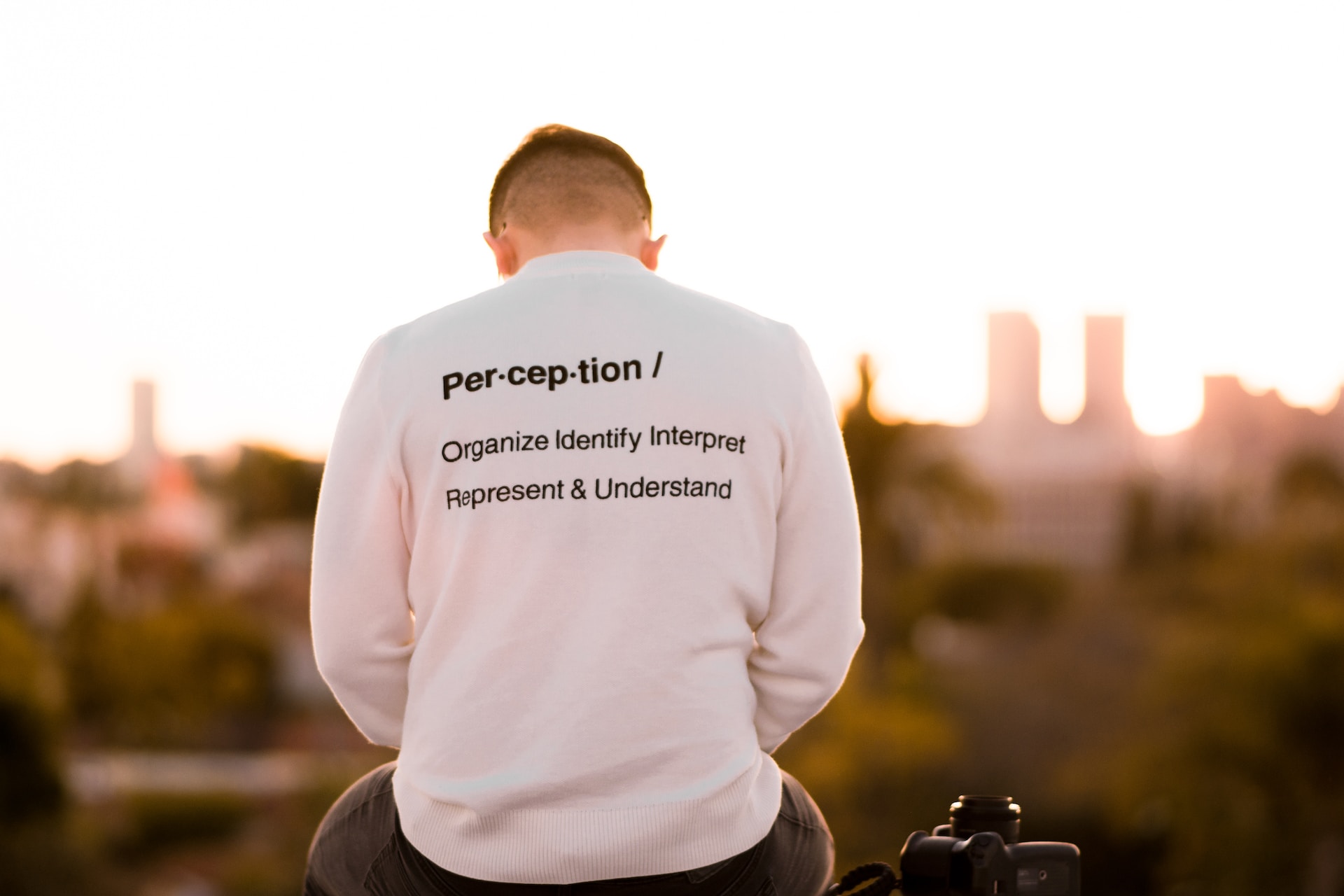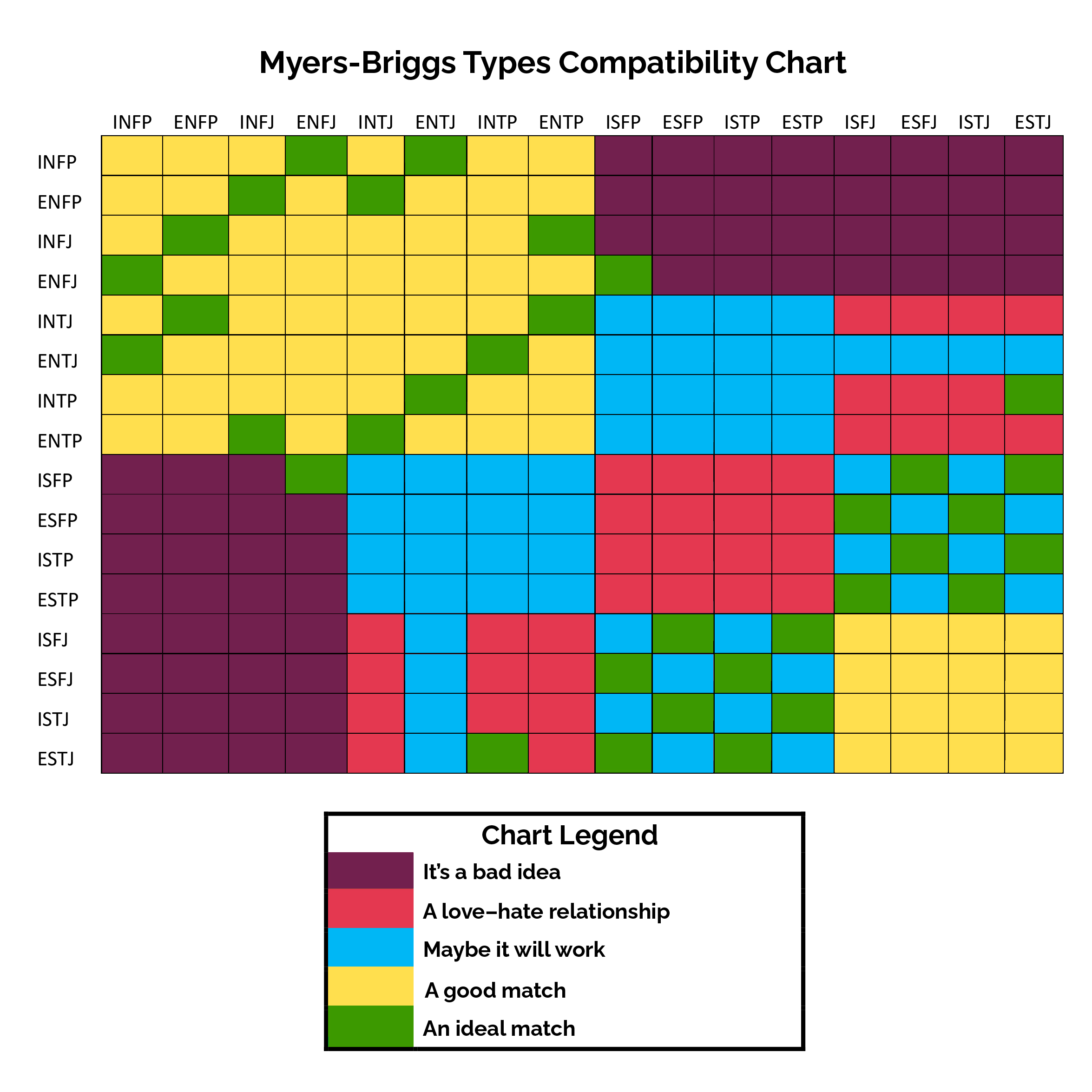Have you noticed that some people seem so close to us, and others seem to be born on a different planet? And sometimes this difference is not evident on the first few dates. Or maybe sometimes we just let ourselves fall in love with the image of a person rather than a real person. We hope that love will change our partner and we will find a common language because our feelings are too strong. Unfortunately, not always dreams come true.
To make the happy-ever-after possible, it is crucial to understand both yourself and your partner very well and start dating mindfully. And MBTI is one of the top instruments to take your first steps in this way.

What Is MBTI?
The Myers-Briggs Type Indicator, or MBTI, is a popular psychological tool used to measure personality preferences and categorize individuals into one of 16 distinct personality types. This self-report questionnaire indicates psychological preferences in how people perceive the world and make decisions. MBTI was created by Katharine Cook Briggs and her daughter, Isabel Briggs Myers, based on the works of Carl Jung.
The Story of MBTI
It took several decades to first develop the method and then test it. Myers and Briggs initially tested the instrument on friends and relatives. Though at first there were only adults in the group, later they started to check the validity of the method on college students and found out that it worked perfectly well for this age also.
Later the forms of the Indicator were tested on the applicants to a large company when Mayers took a part-time job as an HRD. The tool was published in 1962 but got very popular in the 1980s after the death of Isabel Briggs Myers. Many consultants started to apply it to create more efficient teams, help people make career decisions, and just help people improve communication and compassion.
How Does MBTI Work?
The Myers-Briggs Type Indicator (MBTI) makes the theory of psychological types described by C. G. Jung more comprehensible and useful in people’s lives. The test allows you to identify which one of the 16 personality types describes you best based on the combinations of the following parameters.
- Extraversion (E) and Introversion (I) describe whether you prefer to focus on your inner or outer world. Extroverts are usually outgoing and sociable. They like being around people and participating in events. Extroverts prefer to discuss their problems with other people. Introverts are reserved, reflective, and energized by solitude. They like being inside their inner world. Introverts tend to like ideas more than real things.
- Sensing (S) and Intuition (N) describe how you make decisions – based on basic information or interpretations. Sensing is about focusing on physical five feelings and what you hear, see, touch, taste, and smell. Such people usually value experience more than words. People with strong Intuition are more impressed with the information they get. They prefer to carefully consider a problem than to get real experience.
- Thinking (T) and Feeling (F) explain whether you prefer to first look at logic or at the people and special circumstances. Thinking means preferring objective principles and impersonal facts to personal concerns and the people involved, while Feeling means the opposite. People with strong Thinking like to analyze pros and cons and try to avoid personal judgments. People who rely on Feelling pay more attention to the opinions of those who are involved in a particular situation. They think more about setting harmony around them than finding the truth.
- Judging (J) and Perceiving (P) describe whether you prefer to stay open to new information and options or not. People who value Judging prefer to make decisions and plan everything. People who are more about Perceiving are more spontaneous in life and prefer to adapt to circumstances. So, it means that people who prefer Judging are more used to applying Thinking and Feeling in their lives, while people who are more about Perceiving usually rely in their lives on Sensing and Intuition.
The combinations of these four categories make up 16 MBTI types. Why do you need to know it? Because your MBTI compatibility influences the future of your relationship.

What Are 16 MBTI Types?
ISTJ
These people are characterized by their quiet and serious behavior. They achieve success by paying careful attention to every detail. They possess a practical and down-to-earth approach, grounded in a strong sense of responsibility. They make logical decisions about what needs to be done and decisively pursue their goals, regardless of distractions. Finding satisfaction in bringing order to all aspects of their lives, including their work and home, is something they truly enjoy. They hold traditions and loyalty in high regard.
ISFJ
People of this type possess a calm and agreeable nature, being responsible and conscientious individuals. They approach their obligations with unwavering commitment and consistency. Their attention to detail is meticulous, ensuring accuracy in all they do. They are characterized by loyalty and consideration. They genuinely care about the feelings of others and remember important details about the people they like. Their aim is to foster an environment of order and harmony, both in their professional and personal spheres.
INFJ
INFJs actively seek significance and forge connections among ideas, relationships, and material possessions. They possess a genuine curiosity to comprehend the motivations that drive people and demonstrate a remarkable understanding of other people. They remain dedicated to their deeply held values. INFJs cultivate a clear vision of how to effectively contribute to the betterment of society. When it comes to executing their vision, they are organized and resolute, making decisive choices and taking action accordingly.
INTJ
They possess innovative thinking and an immense determination to bring their ideas to life and accomplish their objectives. They have a keen ability to discern patterns in external events and construct insightful, long-term explanations. Once they make a commitment, they skillfully organize tasks and see them through to completion. They approach situations with a healthy dose of skepticism and independence, holding themselves and others to high standards of competence and performance.
ISTP
Such people possess a tolerant and adaptable nature, often observing quietly until a problem arises, at which point they swiftly take action to identify viable solutions. They excel in analyzing the mechanisms behind how things operate and efficiently sift through vast amounts of data to understand the core of practical issues. They exhibit a keen interest in understanding cause and effect and employ logical principles to organize facts. They place a high value on efficiency in their approach.
ISFP
These people have calm and friendly behavior. They are usually sensitive and kind. They take pleasure in embracing the present moment. They value having personal space and the freedom to operate within their own timeframe. Their loyalty and commitment extend not only to their deeply held values but also to the individuals who hold significance in their lives. They have an aversion to disagreements and conflicts, choosing not to impose their opinions or values onto others.
INFP
They possess idealistic qualities and demonstrate steady loyalty towards both their values and the individuals who are significant in their lives. Their curiosity fuels their ability to swiftly recognize possibilities, often serving as catalysts for implementing innovative ideas. They have a genuine desire to comprehend others and actively contribute to helping them realize their full potential. They exhibit adaptability, flexibility, and a high level of acceptance, except when a core value they hold dear is at stake.
INTP
These people have a strong inclination to pursue logical explanations for everything that captivates their interest. They tend to gravitate towards theoretical and abstract concepts, displaying greater enthusiasm for ideas rather than social interaction. Such people are usually quiet, flexible, and adaptable in various situations. They possess an exceptional ability to deeply focus and unravel complex problems within their areas of interest. They approach matters with a healthy level of skepticism, occasionally displaying critical thinking, and consistently applying analytical reasoning.
ESTP
Such people have a flexible and tolerant mindset, adopting a pragmatic approach that prioritizes tangible and immediate outcomes. Theoretical concepts and abstract explanations fail to capture their interest as they prefer to focus their energy on taking decisive action to resolve problems. They prefer to stay in the present moment, embracing spontaneity and cherishing opportunities to engage actively with others. They derive enjoyment from material comforts and have an appreciation for style. Their preferred method of learning is through hands-on experiences and practical application.
ESFP
These people have an outgoing and amiable nature. They accept others and get satisfaction from collaborating with people to accomplish tasks. Their approach to work is grounded in common sense and realism, infusing a sense of enjoyment into their tasks. Such people like being spontaneous and easily adapt to everything new. Their preferred method of learning is by embarking on new skills alongside others.
ENFP
These people have a warm and enthusiastic nature, coupled with a vivid imagination. They perceive life as brimming with boundless possibilities. They have a remarkable ability to swiftly establish connections between events and information, allowing them to confidently act based on the patterns they discern. They greatly value affirmation from others and readily express appreciation and support. Their spontaneity and flexibility enable them to rely on their improvisational skills and verbal fluency to navigate various situations.
ENTP
These people have quick thinking and ingenuity. Their alertness and outspoken nature make them stand out. They showcase resourcefulness when confronted with novel and difficult problems. They excel at generating innovative conceptual possibilities and strategically analyzing them. They possess a keen ability to understand and interpret others. Routine tasks tend to bore them, as they seldom approach things in the same way. Their tendency to explore new interests makes them readily shift from one pursuit to another.
ESTJ
These people possess a practical and realistic mindset, approaching everything in a matter-of-fact manner. They demonstrate decisiveness and swiftly take action to implement their decisions. They excel in organizing projects and people, ensuring tasks are accomplished efficiently and with a focus on tangible results. Routine details are something they handle with care. They uphold a clear set of logical standards and diligently adhere to them, expecting the same from others. When it comes to executing their plans, they exhibit a forceful determination.
ESFJ
People who belong to this type are warm and compassionate. They have a strong sense of responsibility and a cooperative attitude. They actively seek harmony in their environment and work diligently to establish it. They find joy in collaborating with others to ensure tasks are completed accurately and punctually. Their loyalty shines through as they follow through on even the smallest matters. They have a keen awareness of the needs of those around them in their day-to-day lives and strive to fulfill them. They desire to be acknowledged and appreciated for both who they are as individuals and for the contributions they make.
ENFJ
These people have a warm and caring nature, showing empathy and responsiveness to those around them. They have a keen ability to understand and connect with the emotions, needs, and motivations of others. They genuinely believe in the potential of every individual and actively strive to help them realize their capabilities. In both personal and professional settings, they can act as catalysts for personal and collective growth, igniting positive change. Their loyalty is unwavering, and they value and learn from both praise and constructive criticism. They excel in social settings, adeptly facilitating group dynamics and providing inspirational leadership that motivates and empowers others.
ENTJ
Confident and assertive, they naturally step into leadership roles. They have a keen eye for identifying illogical and inefficient procedures and policies, and swiftly developing and implementing effective systems to solve organizational challenges. They derive satisfaction from engaging in strategic planning and setting ambitious goals. Typically well-informed and intellectually curious, they actively seek knowledge and take pleasure in sharing it with others. They possess a compelling presence when presenting their ideas, expressing their opinions with conviction and force.
How Can the Knowledge of Your MBTI Type Help You Better Understand Yourself?

The destiny of a relationship depends a lot on choosing the right partner. Still, before thinking about MBTI compatibility with someone else, it is important to understand what comes from your type – the things that are crucial to you.
Know Your Communication Style
Our MBTI types can affect how we communicate and express ourselves in relationships. Depending on whether you lean towards extraversion or introversion, your communication style can vary. If you’re more of an extrovert, say, ENFP or ESFP, you’re likely to be outgoing and expressive, readily sharing your thoughts and feelings with your partner. On the flip side, if you tend to lean towards introversion, like ISTJ or INFJ, you might prefer quieter and more introspective communication, valuing your own space and privacy.
Knowing your communication style is a game-changer. It helps you understand how you naturally express yourself and connect with others. Once you have this insight, you can adapt your approach to effectively communicate and relate to your partner, which is already a good start for MBTI compatibility.
Know Your Way of Recharging
MBTI types play a role in how people replenish and manage their energy within relationships. For example, if you have an extraversion preference (identified by the “E” in your MBTI type) you may feel energized by engaging in social activities and being around others. In a relationship, you may find that quality time with your partner, exploring new activities together, or being in the company of friends brings you joy and rejuvenates your energy levels.
In contrast, if you lean towards introversion (represented by the “I” in your MBTI type), you might require periods of solitude and introspection to recharge your energy reserves. After a busy day, you find comfort in quiet moments alone, such as reading a book, taking a peaceful walk in nature, or engaging in a creative hobby. Recognizing these differences allows you and your partner to appreciate and honor each other’s need for personal space. Logically, this difference between extraversion and introversion can be a problem for MBTI compatibility if partners don’t pay enough attention to balancing their needs.
Know How You Make Decisions
Relationship implies making a lot of decisions, and partners can have a totally different approach to this process. Of course, this difference can damage MBTI compatibility. Conflicts can happen if partners are not aware that they tend to decide in a particular way influenced by their MBTI types. If people don’t leave space for a different opinion, it can become a problem. Let’s check some examples.
If you have a preference for thinking, denoted by the “T” in your MBTI type, you tend to make decisions based on logical analysis and objective criteria. You weigh facts, evidence, and practical considerations when faced with choices. In a relationship, you may prioritize finding the most efficient and rational solution to a problem or making decisions based on logical reasoning.
On the other hand, if you lean towards feeling, represented by the “F” in your MBTI type, your decision-making process takes into account values and emotions. You consider the impact of choices on the well-being and happiness of yourself and others. In a relationship, you may prioritize maintaining harmony and empathy, and considering the emotional needs of your partner when making decisions.
This awareness can foster understanding and collaboration, leading to more harmonious and satisfying decisions within your relationship.
Know Your Needs in the Relationship
All MBTI types have distinct priorities and preferences. For example, if you lean towards thinking, you might value logical analysis and finding practical solutions in your relationship. On the other hand, if the feeling is more your style, you might prioritize emotional harmony and empathy, focusing on nurturing a deep emotional connection. The combination of these styles also influences the MBTI compatibility in a couple.
Imagine you’re an INTJ (Introverted, Intuitive, Thinking, Judging) type. As an INTJ, you tend to prioritize logical analysis and problem-solving in your relationships. For you, it’s crucial to have a sense of intellectual compatibility and to feel intellectually challenged in the relationship. And let’s consider an ESFP (Extraverted, Sensing, Feeling, Perceiving) type. As an ESFP, you place a high emphasis on emotional harmony and connection. You enjoy engaging in activities that stimulate your senses and create memorable experiences with your partner.
By recognizing and understanding these needs, you gain a deeper understanding of your own desires and what makes you tick in a relationship. Once you have this self-awareness, you can effectively communicate your needs and preferences to your partner, fostering a stronger and more fulfilling connection.
Take a moment to reflect on your own needs and preferences, and then open up a heart-to-heart conversation with your partner. This is probably the best recipe for MBTI compatibility.
Learn to Resolve Conflicts Faster
The way you handle conflicts in relationships can be influenced by your MBTI type. Some types may prefer assertive confrontation, directly addressing issues without hesitation, while others may prioritize harmony and tend to avoid conflicts. Understanding your unique conflict resolution style can assist you in effectively navigating disagreements and reaching compromises with your partner, regardless of your theoretical MBTI compatibility. Let’s take some examples.
ESTJ (Extraverted, Sensing, Thinking, Judging) type, for instance, tends to tackle conflicts head-on with a direct and assertive approach. In a conflict, they may openly express concerns and expectations, engaging in active problem-solving discussions.
And let’s consider an INFP (Introverted, Intuitive, Feeling, Perceiving) type. Such people prioritize emotional harmony and may be more inclined to avoid conflicts altogether. They value empathy and understanding. In a conflict, they may prefer to reflect privately on their feelings and thoughts before addressing the issue.
These examples show how different MBTI types can approach conflict resolution in different ways. By understanding your own tendencies and recognizing those of your partner, you can avoid quarrels and talk more effectively no matter what the science says about your MBTI compatibility.
How to Determine MBTI Compatibility with Your Partner?

Some experts have made attempts to determine compatible personality types using the Myers-Briggs test. For example, Barbara Barron and Paul D. Tieger, in their book “Just Your Type: Create the Relationship You’ve Always Wanted Using the Secrets of Personality Type,” discuss the idea that many personality types tend to experience greater satisfaction when paired with similar partners which can be called MBTI compatibility. According to their research, specific pairings – SJ (sensing and judging) and NF (intuiting and feeling) – have shown romantic satisfaction rates exceeding 70%.
Additionally, Barron and Tieger discovered that MBTI compatibility tends to increase when both partners possess a preference for feeling, even if they differ in other aspects. This could be attributed to the fact that feelers invest significant energy into their relationships and often prioritize open communication. So, these combinations are quite successful as well:
ISTJ, ESTJ, ISFJ, and ESFJ
INFP, ENFP, INFJ, and ENFJ
What Are Popular MBTI Compatibility Theories?
Several theories describe which types are more compatible than others. Here are the most popular ones.
MBTI Compatibility Based on Type Complementarity
The theory of Type Complementarity suggests that individuals with complementary MBTI types may experience better compatibility in relationships. Individuals who possess different preferences in certain dichotomies can balance each other out and enhance the dynamics of their relationship.
For instance, in the case of extraversion (E) and introversion (I), an extroverted person tends to thrive in social settings, while an introverted person typically enjoys more solitude and introspection. Through their complementary nature, an extroverted individual can provide social stimulation and encourage the introvert to engage in more social activities. At the same time, the introverted person can offer a calming influence and provide the extrovert with opportunities for introspection and personal reflection.
Similarly, the complementarity of thinking (T) and feeling (F) preferences can contribute to relationship harmony. Thinking individuals tend to prioritize logical analysis and objective decision-making while feeling individuals place importance on empathy and emotional considerations. By combining their perspectives, a thinking person can provide a rational viewpoint and logical problem-solving skills to navigate emotionally charged situations, while a feeling person can bring empathy and emotional support, fostering a deeper understanding of each other’s emotions.
MBTI Compatibility Based on Type Similarity
The theory of Type Similarity says that individuals with similar MBTI types may experience better compatibility in relationships. According to this theory, individuals who share similar preferences across the four dichotomies of the MBTI can enhance their understanding and connection with each other. The underlying assumption is that shared preferences create a common language and framework for communication, so such couples usually have fewer barriers and more mutual understanding.
When individuals possess similar MBTI types, they often have comparable ways of perceiving and interacting with the world. For example, two individuals with a preference for extraversion (E), intuition (N), feeling (F), and perceiving (P) might find it easier to relate to one another as they share common approaches to gathering information, making decisions, and engaging in social interactions.
However, it is important to note that the theory of Type Similarity is not universally accepted. Other factors such as values, interests, and personal growth also contribute significantly to relationship compatibility.
MBTI Compatibility Based on Type Flexibility
The theory of Type Flexibility proposes that compatibility in relationships is not solely determined by MBTI types, but also by an individual’s capacity to adapt and understand different types. This theory highlights the importance of flexibility and adaptability in interpersonal dynamics.
The theory of Type Flexibility suggests that by recognizing and accommodating the differences between types and individuals, you can foster better understanding and rapport with your partner.
MBTI Compatibility Based on Type Pairings
Some proponents of MBTI compatibility theories have put forward specific type pairings believed to have strong compatibility based on the cognitive functions associated with each type. These pairings suggest that certain types share compatible cognitive processes, leading to effective complementarity. One example is the pairing of INTJ (Introverted-Intuitive-Thinking-Judging) and ENFP (Extraverted-Intuitive-Feeling-Perceiving).
This theory is proved by a study published by ResearchGate. The study suggests that some types are way more compatible with each other than others because of their close interests and patterns of behavior. Here are those successful matches. Check if you are one of them below.
ENFJ and INFP
ENFJs and INFPs are believed to be compatible due to their shared values, depth of emotions, and ability to provide emotional support to each other. They both have a strong preference for Feeling (F) and can connect on an emotional level. ENFJs bring organization and decisiveness, while INFPs contribute creativity and flexibility, creating a balanced dynamic. The objective of both of them is to find lasting love. When conflicts or challenges inevitably emerge within a relationship, their natural inclination is to diligently strive toward reconciliation.
ENTJ and INFP
ENTJs and INFPs are believed to be compatible due to their cognitive function complementarity, which balances logical analysis and emotional understanding. They provide opportunities for mutual growth and learning, appreciate each other’s differences, and create supportive dynamics. INFPs are drawn to the intensity, ambition, confidence, and leadership capabilities of ENTJs. They find the ENTJs’ nature and ability to transform plans into reality inspiring, making them believe in their own potential to achieve their dreams.
ENTJs are attracted to the warmth, sincerity, creativity, and perceptive nature of INFPs. They appreciate the INFPs’ selfless qualities and are impressed by their exceptional listening skills, finding comfort and admiration in their presence.
INFJ and ENFP
INFJ and ENFP MBTI types are considered compatible because they share key traits such as intuition, feeling, and the desire for emotional connection. They can have deep, intellectual conversations and appreciate each other’s authenticity. INFJs provide stability while ENFPs bring excitement, creating a balanced dynamic. These two types usually share values and support each other. This relationship is filled with understanding and acceptance.
INTJ and ENFP
INTJ and ENFP MBTI types are considered compatible due to their complementary cognitive functions. INTJs can provide logical analysis and structure, while ENFPs contribute with their creativity and openness to possibilities. They also share intuition, abstract thinking, and a desire for personal growth. Both these types tend to value their differences and support each other in self-improvement.
ENTP and INFJ
ENTP and INFJ MBTI types are also considered to be a good couple because they have complementary cognitive functions (Extraverted and Introverted). They also both like deep and thought-provoking conversations. These types value depth and wisdom. These people value personal growth and support each other in this way. The difference in these MBTI types is rather the thing that balances each other than the thing that brings conflicts. INFJs can provide a calm and supportive presence for ENTPs when they need introspection or reflection.
ISFP and ENFJ
ISFP and ENFJ MBTI types usually match well because of their complementary Introverted and Extroverted functions. Both these types value harmony and authenticity in relationships and that’s why they have a deep emotional connection. Both these types appreciate creativity, mutual growth, and effective communication. They can establish a strong emotional bond, support each other’s personal development, and share an appreciation for beauty. ENFJs are skilled at expressing themselves and are attentive to the emotional needs of others, while ISFPs are good listeners and value open and honest communication. This makes them a nice couple.
ENTP and INTJ
ENTP and INTJ types are considered compatible due to their shared intuitive and thinking preferences. These people will have a great time discussing complex ideas and exercising their brains. They will easily understand and appreciate each other’s abstract thinking and shared interest in exploring new ideas and concepts. Their complementary functions can lead to a dynamic and balanced partnership. For example, ENTPs can bring spontaneity, adaptability, and innovative thinking to the partnership, while INTJs can contribute with their strategic planning, focus, and logical analysis.
INTP and ENTJ
INTP and ENTJ are considered compatible because of their complementary cognitive functions – Introverted Thinking and Extraverted Intuition. This difference allows this couple to find a balance between abstract thinking and logical analysis. These people are interested in intellectual exploration and growth, they willingly share ideas. These types often have similar values, such as competence, efficiency, and intellectual pursuits. These people will support each other’s personal and professional development, and share a drive for success.
ESTJ and ISFP
Actually, opinions differ regarding the compatibility of ESTJ and ISFP MBTI types. They have significant differences, however, some potential compatibility can be found in their complementary strengths, appreciation for differences, mutual support, and open-mindedness in communication. Still, they will have to learn to respect each other’s preferences for noisy and calm relaxation.
ESFJ and ISFP
ESFJ and ISFP are often mentioned as compatible types because of their complementary functions – Extraverted Feeling (Fe) and Introverted Sensing (Si). Together, they can strike a balance between emotional understanding and practical engagement with the external world. The thing that will keep them together is their shared feeling and preference. Both types prioritize harmony, empathy, and emotional well-being in their relationships. They can create a harmonious relationship through their emotional connection, support for personal growth, and shared interests.
ISTJ and ESFP
ISTJ and ESFP MBTI types are not typically considered highly compatible due to their significant differences. ISTJs value order, structure, and practicality, while ESFPs enjoy spontaneity, excitement, and living in the present moment. Though this difference can become a problem for their couple, it can also be a perfect resource to balance each other’s lives. These types can provide support to each other in various ways. ISTJs can offer stability, reliability, and practical advice to ESFPs, while ESFPs can bring joy, spontaneity, and a sense of adventure into the ISTJs’ lives. They may find common ground in activities that involve sensory stimulation, such as exploring nature, food, or physical activities.
ISFJ and ESFP
What makes ISFJ and ESFP types are compatible because of their feeling preferences and appreciation for sensory experiences. They both prioritize harmony, empathy, and consideration of others’ feelings. They may find shared enjoyment in activities such as exploring nature, trying new foods, or engaging in physical experiences together. At the same time, their complementary traits will help them understand and balance each other’s strengths, and provide support in various aspects of life.
ESTJ and ISTP
Such MBTI relationships are also not commonly considered highly compatible. They have significant differences. However, these common points can help them develop a good relationship. For example, they both value independence and autonomy and can create a relationship based on mutual respect. They both prefer sensing, which means they tend to appreciate concrete details and live in the present moment. While challenges may exist, these types can find a way to use their differences to support each other, solve problems together, and balance each other.
ESFJ and ISTP
Some experts share the idea that ESFJ and ISTP are compatible, and some don’t. In general, these MBTI types share a preference for sensing, which can let them spend a nice time together engaging in sensory activities. Some potential compatibility can be found in their complementary strengths, appreciation for differences, and opportunities for learning from each other and growing together. This relationship will work if ESFJs let their ISTPs partners have enough time to themselves, while ISTP personalities learn to be more open with their own feelings.
What MBTI Types Are Incompatible?
Just like there are types that match very well, some combinations may present more challenges. Still, it doesn’t mean that you should end your relationship the moment you get to know about your bad MBTI compatibility. When you love someone, you can always find a way to agree on things and learn from the differences you have. As there are some combinations that are generally considered more challenging, we will give you some examples below. You can check this MBTI compatibility chart to get more information about your types. 
INFP and ESTJ
This first obvious mismatch is explained by totally different approaches to decision-making and communication can lead to misunderstandings and conflicts, which can result in numerous conflicts. INFPs value personal values, individuality, and emotional expression, while ESTJs focus on practicality, efficiency, and following established systems.
ENFP and ISTJ
The combo of ENFP and ISTJ is one more kind of challenging MBTI relationships. ENFPs are often imaginative, enthusiastic, and value personal freedom, while ISTJs are typically detail-oriented, practical, and prefer order and structure. These differences can create challenges in understanding each other’s needs and priorities. ISTJs generally prefer structure, predictability, and a planned approach, whereas ENFPs are more spontaneous, adaptable, and open to new possibilities. In addition, their contrast in emotional expression can lead to a lack of understanding or misinterpretation of each other’s emotional needs.
ENFJ and ISTP
One more challenging combination is ENFJ and ISTP. They have very different communication and decision-making styles. ENFJs are expressive and value emotional connection, while ISTPs are often reserved and prefer practical, action-oriented communication. ENFJs typically prefer organized and planned approaches, whereas ISTPs are more spontaneous and flexible. Their contrasting approaches to life and communication can lead to difficulties in understanding and meeting each other’s needs.
ISTJ and ENFP
One more example of a bad match is ISTJ and ENFP. They can have conflicts because ISTJs tend to be more reserved and straightforward in their communication, while ENFPs are often more expressive. Logical ISTJs will feel strange together with emotional ENFPs. At the same time, a typical ENFP can find a rigid, focused-on-planning ISTJ too boring and inflexible. Their contrasting approaches to life and decision-making can create potential conflicts and misunderstandings.
How to Understand Your MBTI Type?

To check your MBTI type, you can use one of the following strategies.
Practice Self-Reflection
This is probably the hardest way which takes a very conscious approach to life. You need to take some time for self-reflection and consider your preferences in different life situations. Think about how you collect information, make decisions, interact with others, and approach tasks or projects.
Read About MBTI Types
Just reading carefully about types can help you notice some patterns in your behavior. Familiarize yourself with the descriptions and characteristics of each of the 16 MBTI types. Read about the preferences, strengths, and potential areas for growth associated with each type. Are some traits typical of you as well? This can help you gain a better understanding of the different types and see which descriptions resonate with you.
Take Online Tests
Take online MBTI tests to get an initial indication of your type. Though you should remember that online tests can give you only a very approximate result. The results will depend a lot on how accurately you answer questions and how honest you are with yourself. Also, online tests don’t provide enough contextual information and often have too simplified questions. Still, despite these limitations, online tests can give you some clues and they are offered for free on many websites.
Take an Official MBTI Assessment
Actually, MBTI is a psychological assessment that should be carried out by certified professionals. So, if you want to get the most accurate results, you should find a practitioner who will help you determine your type. On the official website of the Myers & Briggs Foundation, you can find both online and offline options.
What Is Next?
MBTI is a powerful tool to learn more about yourself and your partner. By knowing your preferences and behavioral patterns, you will be more aware of how it influences your life and your relationships with other people. And the more you understand yourself, the better life choices you make.
If you are single, you can pay attention to MBTI compatibility with potential partners and focus more on those people with whom you can have more in common. If you are already in a relationship, you can use MBTI to understand the differences between you and your partner and mitigate conflicts. Next time you find yourself in a quarrel, consider analyzing whether the real problem lies in differing perspectives between you and your partner. Attempt to see the situation from your partner’s point of view, and you will notice how many conflicts get resolved more quickly.


